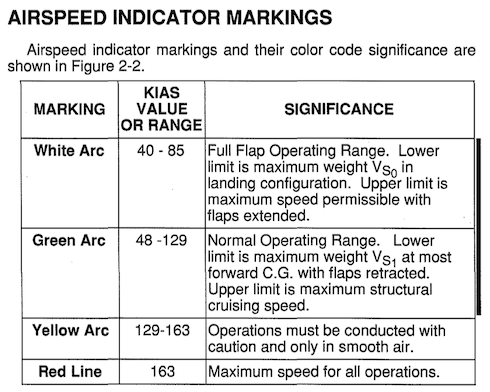Short answer
At low speed, near the stall, 40 KIAS (the low end of the white arc) and 48 KCAS (Vs0 in the POH) refer to the same actual speed. While there is a limited divergence (0 to 2%) between CAS and IAS at medium and high speed, this difference can be as much as 20% at low speed, when the aircraft pitch is large.
Details
In your question, you mention:
- The POH states a Vs0 of 48 KCAS.
- The low end of the airspeed indicator white arc is 40 KIAS.
The end of the white arc is also Vs0. That's a bit confusing indeed as two types of measures are used, but in fact they refer in practical to the same actual airspeed.
Indicated airspeed
Unless computations are done, airspeed values displayed to the pilot IAS (indicated airspeed).

(Source)
Errors affecting IAS
IAS reflects directly the difference between the total air pressure in the pitot tube, and the (mean) static air pressure at different static air pressure ports (on the side of the aircraft and in the pitot). The difference (the dynamic pressure) is subject to possible errors:
Total air pressure is wrong it the probe axis is not parallel to the airflow. Obviously the pitot tube angle changes between low and high speeds. For a given speed the pitot pitch also varies with mass and balance, and the status of drag devices such as flaps and landing gear.
Static air pressure at a pressure port is likely affected by pressure variations created by the aircraft fuselage. This error greatly depends on the port location and its design, but also on the yaw angle.
Airspeed indicator itself.
Obtaining CAS from IAS
All V-speeds are defined in term of "calibrated" airspeed (CAS). The aircraft manufacturer provides tables to find the CAS from the IAS read on the airspeed indicator. These tables defined for different drag devices status (e.g. flaps values) are valid at sea level and 15°C. They are included in the POH. I found this C172N one online:

(Source: POH C172N 1978)
For a 40° full flaps the table says that 40 KIAS are actually 47 KCAS. This is close to the 48 KCAS in your POH.
As you realized, the difference between KCAS and KIAS becomes larger as the air speed decreases, because the angle of attack and the errors in pressure measurement increase.
Multiple ways to express airspeed
TAS depends on parameters and need to be computed. However it can be approximated by the indicated airspeed. IAS is close to the TAS in favorable atmospheric conditions (sea level air density), and at low angles of attack.
The IAS is easy to display to the pilot using the an aneroid cell. For higher angles of attack, the calibrated airspeed (CAS) corrects for instrument and probe placement errors. CAS can be obtained using manufacturer tables. CAS, as IAS, is valid at sea level and 15°C.
When the air temperature or pressure are not close to the ideal ones (15° and 1013 hPa), then CAS differs from TAS.
The ASI usually has a window (see above) for reading the TAS after the outside temperature and altitude pressure have been selected.
(At speed higher than 200 KCAS or altitude higher than 10,000 ft, the compressibility of air becomes significant, and the equivalent airspeed (EAS) is better suited to describe the aerodynamic effects.)
Vs0 is determined assuming the maximum landing weight and the most unfavorable CG location. It is expressed in KCAS. If the Vs0 CAS were unknown, the pilot wouldn't be able to correct it to include the effect of weight and balance changes.
The ASI, because no correction is done, can display only IAS. So the IAS value for the lower speed of the white arc (Vs0) is in KIAS.




